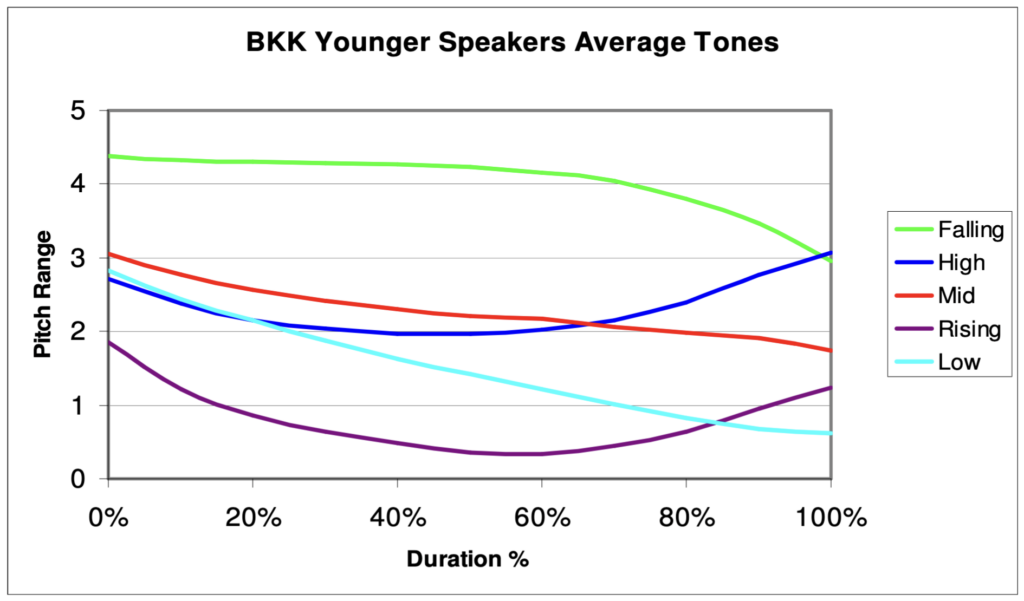Outdated description
If you’re a Thai learner, you’ve probably seen a variation of this diagram before:
However, this diagram is actually not representative of modern Thai tones (!)
This diagram is based on research done by Arthur Abramson in 1962. In other words, this represents the state of Thai tones approximately 60 years ago. However, 60 years is a long period of time for language to change; just imagine how English (or any other language) sounded 60 years ago. I guarantee you it didn’t sound like it does today.
In addition, Thai tones have been particularly volatile over the past century. You can reference Pittayaporn 2007 for a full overview, but the key diagram to illustrate this point is:

The key take-away from this diagram is that the tones have changed significantly over the course of the last century, with some of the biggest changes being:
- The rising tone has changed from a sharp low-to-high pattern into a pattern described by “starts in the bottom of the range, stays low, and then ends only with a mid offset” in Pittayaporn 2007, unlike the dip and high-ending rise depicted in Abramson’s diagram.
- The falling tone has changed from a mid falling tone to a high falling tone with a peak late in the syllable (rather than an early peak like Abramson’s diagram suggests).
- The high tone has “lowered its onset to the true mid region” (Pittayaporn 2007), rather than the higher start depicted in Abramson’s diagram.
Keep reading for an even more complete description of the modern tone values. Also, if you’re worried about how to memorize all this, take a look at my article summarizing Thai phonology with convenient reference charts.
More about Thai phonology
Accurate modern tones
So, with all these changes (and some others all around), the most accurate and up-to-date depiction of the modern Thai tones can be found in Thepboriruk 2009:

Note the following:
- The falling tone barely even falls into the mid region.
- The high tone actually starts in the middle of the pitch range, and is really more of a mid rising tone with a slight dip in the middle.
- The mid tone actually gradually falls downward rather than remaining level.
- The rising tone starts much lower than all the other tones, but doesn’t even rise past its starting point.
- The low tone actually starts above (!!) the high tone and falls sharply downward.
So, to summarize, modern Thai tones are actually totally different than what’s generally taught in textbooks, the internet, etc.
So, for you as a Thai learner, it’s very important to keep in mind that the descriptions you’ve likely heard about the Thai tones are incorrect. Instead, reference the diagrams in this article as you conduct your listening and speaking practice so that you can start pronouncing the tones like modern speakers, rather than those from the previous century.
Conclusion
Thai tones have undergone a huge amount of change just within the last century, to the point where the traditional descriptions of Thai tones are no longer accurate; refer to Figure 3 for the most up-to-date reference for the exact realizations.
The real take-away, though, is actually to combine what’s written in this article with actual careful listening. The reason I even thought to investigate all this in the first place was because my ears were telling me something very different than what the literature describing Thai tones lead me to expect. The key to developing a native-like accent is to be aware of the details presented here, while also listening very closely to natives, copying them, and repeating that over and over until your speech sounds the same as whatever recording / speaker you’re copying.
Related Posts
Sources
- Abramson, A. S. 1962. The Vowels and Tones of Standard Thai: Acoustical Measurements and Experiments. (International Journal of American Linguistics, 28.2.) Bloomington: Indiana University.
- Pittayaporn, P., 2007, August. Directionality of tone change. In Proceedings of the 16th International Congress of Phonetic Sciences (ICPhS XVI) (pp. 1421-1424). Saarbrücken, Germany: Saarland University.
- Thepboriruk, K., 2009. Bangkok Thai tones revisited.